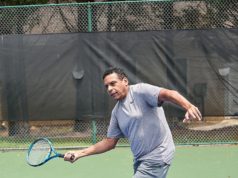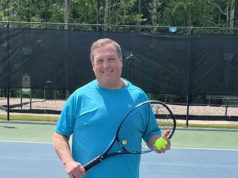By Dr. Mark Kovacs, CTPS, MTPS; CEO, Kovacs Institute; Executive Director International Tennis Performance Association
Have you ever watched professional players play a match live? Did you notice how hard they hit the ball and how well they moved? These players usually have great technique, but they also have committed themselves to performing strength training exercises that allow for effective energy transfer for each stroke, as well as muscular endurance (or strength endurance) to perform tennis strokes at a high level for an extended period. One of the questions we get the most at our institute is whether a league tennis player should have a tennis-specific strength training workout. The simple answer is a resounding YES.
From an athletic perspective, absolute strength is the largest amount of force that an individual can produce, irrespective of the time it takes to move the force. Think about when you may be performing a lunge movement. Absolute strength would be measured by how many pounds (or kilograms) is on the bar (or the dumbbells). Power, on the other hand, is defined as the amount of work performed per unit of time. Therefore, the absolute resistance is only half of the equation. The time to move the resistance is just as important. To be powerful, you need to have a required amount of strength and then be able to move forces quickly. For tennis players, it is important to not only focus on strength (how much you can lift), but also on power (how quickly you can lift a weight safely). The challenge for many competitive, recreational players is the type of strength training. We also recommend you work with a qualified individual to help you set up a tennis-specific strength training program. Look for a Certified Tennis Performance Specialist (CTPS) through the International Tennis Performance Association (iTPA). These individuals are trained to work with tennis athletes to offer tennis fitness programming.
Here are a couple of tips that should help you when researching the best strength training options to improve your tennis:
“Weak legs command. Strong legs obey.” This quote by Gil Reyes, long-time strength coach for Andre Agassi, is one of the most valuable for every tennis player. I have been fortunate to spend over a decade working closely with Gil; this is one of his favorite themes when working with tennis athletes. If your legs are not strong, they will not do what your mind and the rest of your body wants them to do. Getting strong allows you to load better on wide balls, have a more stable base during rally balls, move quicker around the court, and change direction faster. General strength training will provide some general benefits, but tennis-specific strength training will provide tennis-specific benefits.
“A chain is only as strong as its weakest link.” This proverb was never about tennis, but the theme applies to injury risk for tennis players. If you have certain weaknesses anywhere along your chain (your body), the weakest point will likely breakdown. Understanding your weaknesses, and training strategically to correct them, will provide great benefit to every tennis athlete. The areas of typical concern for recreational tennis players are the shoulders, the knees, the lower back, the elbows, and the calves (for older, male athletes). Make sure you are doing some preventative work on these areas multiple times per week.




